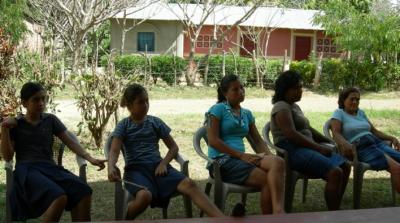migration in ochomogo

This past week my collaboration with Servicio Jesuita de Migrantes (SJM) took an exciting turn as I conducted two days of intensive fieldwork with a SJM colleague in the rural community of Ochomogo, in the department of Rivas, about 2 hours south from Managua by bus. Rivas is the southwest department (state) bordering Costa Rica, and the community of Ochomogo is heavily impacted by migration, with nearly every household having at least one family member (mother, father, husband, wife, brother, sister, grandchild) in CR. I’ve been asked by folks in the US why Nicaraguans emigrate to CR. The short, simple response = for economic reasons. In agricultural communities impacted by droughts, flooding, lack of government investment, inability to access credit, jobs, education, and opportunities in general, people leave "para mejorarse" -- in search of a better life. Their destination is CR for many reasons: geographical proximity, relative lower cost of transit (in compared to the trip to El Norte/the US), demand for low wage immigrant labor in the CR economy, and relatively better incomes compared to what would be earned for similar work in Nicaragua (e.g. women working as domestics in Managua may make $200USD/month, whereas in San José CR, the same work earns a salary of about $500USD). For men, employment in the Tica (Costa Rican) economy is in agriculture or construction; for women, in domestic service or agriculture. With SJM in Ochomogo, we conducted interviews with returned migrants and family members, focusing on human rights violations experienced in transit, while living in CR, or in deportation/return. The next morning, we conducted a half-day workshop on the rights of documented and undocumented migrants under the UN "Convention of 1990" (see earlier blog post on Foro de Migraciones), as well as the steps to obtain legal documentation. I hope for my collaboration with SJM to be ongoing; it is incredibly rewarding to work alongside like-minded and compassionate people. I also plan for Ochomogo to be the site for my next round of data collection. I’ve already met two families for my study there, and hope to add several more in the next couple months. I currently have 10 families in my study, with whom I’ve conducted the bulk of my data collection. My goal is to identify another 10 families next year, for a total of around 20 families by the end of fieldwork. That’s my update from the field; now back to all this virgin mary madness... [note: pictured are women participants in our SJM workshop, all of whom have migrant experience or are family members of migrants. the house in the background is typical of those that have achieved some "mejoras" (improvements) due to migration: the paint, the room addition, the new zinc (corrugated iron) roof, and the ceramic tile (as opposed to dirt) floors being just some of the things that remittances typically buy for families back home.]
1 comentario
Angela -